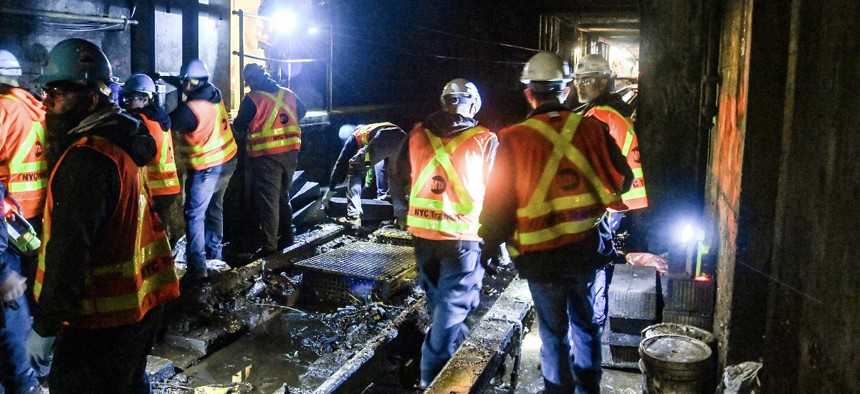MTA
DiNapoli: MTA needs $43B for repairs and upgrades
The costs estimates were detailed in a new report released by the state comptroller detailing the agency’s needs assessments over the next 20 years, starting in 2025.

Metropolitan Transportation Authority workers responding to heavy rains and flooding in a subway tunnel on Friday, Sep 29, 2023 (Marc A. Hermann / MTA)
State Comptroller Thomas DiNapoli estimated the Metropolitan Transportation Authority needs $43 billion to fund repairs and upgrades over 20 years starting in 2025, according to a new report released by his office, detailing the agency’s aging infrastructure and procurement issues.
DiNapoli in the report released Thursday urges the MTA to list its priorities, given the limits to how much funding would be available. With New Yorkers up and down the state grumbling about train delays and service issues, the MTA has been under pressure to deliver improvements. According to DiNapoli’s report, they can’t come a moment too soon.
His report estimates that adjusted for inflation, at least $43 billion will be needed for the MTA’s next capital program period between 2025 and 2029. The cost to replace 3,900 subway cars over the next 20 years could be $15 billion. The report also estimates that adjusted for inflation, $69 billion was needed between 2015 and 2024 for two capital programs. Based on his office’s review of a 20 year needs assessment completed in 2023, much of the MTA’s facilities need significant repairs. The comptroller provided his own financial estimates of the improvements after the agency chose not to include projected costs in the assessment.
The report rated several facilities as being in “poor or marginal condition.” That included 73% of the New York City subway’s rail car maintenance buildings; 69% of the roofs at maintenance-of-way support shops; 100% of the Park Avenue train shed structural supports, roof slab, drainage system and HVAC system at Grand Central Terminal; and all of the Long Island Railroad’s platforms at Penn Station.
DiNapoli's report also outlined a disconnect between financial commitments laid out in the MTA’s 2013 twenty-year needs assessment and actual spending. For example, the MTA said an inflation-adjusted $1.3 billion would be needed for LIRR capital programs between 2015 and 2024 but only $733 million has been spent. At that same time, the MTA estimated that Metro-North would need an inflation-adjusted $1.2 billion for tracks and infrastructure but as of now only $336 million has been spent.
“Prior capital programs were delayed by as long as 18 months because funding details were not ironed out,” DiNapoli said in a statement. “With the urgent need to increase ridership, boost revenue and secure its future, the MTA cannot afford delays in upgrades and repairs that will improve the transit system.”
The MTA said instead their most recent assessment was the most comprehensive in its history. "This 20-Year Needs Assessment is the most comprehensive in MTA history, laying out in great detail the urgent need for continued investment in the transit system,” said MTA spokesperson Meghan Keegan in an email. “It will provide a vital framework as we develop the next 5 Year Plan-- including cost estimates-- to address needs like state of good repair, resilience, and accessibility."
The MTA regularly releases financial need assessments and it used to be standard practice to include funding estimates and spending figures for its capital programs in those plans. In the 2023 assessment, no such estimates or figures were present.
Adding to delays, congestion pricing lawsuits have held up some of the $15 billion meant to fund repairs and other projects in the MTA’s $55 billion 2020-2024 capital plan. Last week, Metropolitan Transit Authority CEO Janno Lieber told lawmakers in a budget hearing on transportation that the litigation was preventing some contracts from being finalized.
DiNapoli’s primary issue with the needs assessment’s omission of financial estimates is that without them, stakeholders and decision-makers don’t know the MTA’s priorities. Between aging signals that the report says are responsible for 25% of subway delay incidents and cyclical Metro-North renovations, there are many areas of focus for the MTA.
“(The) MTA’s decision to not include costs in its last Needs Assessment,” DiNapoli said, “presents a challenge for its stakeholders that underscores the need for MTA to state as early as possible what level of funds it will need from outside sources to pay for its capital program and the growing cost of its important efforts to strengthen the system’s resilience and accessibility.”

